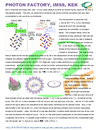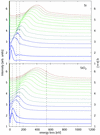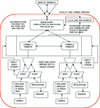issue contents
March 2008 issue

Cover illustration: X-ray fluorescence imaging of tooth sections performed at the APS reveals that mercury from dental amalgams migrates through human teeth to an area with an active bloodstream (see Harris, Vogt, Eastgate, Legnini, Hornberger, Cai, Lai and Lay, pages 123-128). The mercury map (bottom left) also indicates that mercury accumulates in calculus on the right-hand side of the tooth. Hg L3-edge MicroXANES (bottom right) indicates that mercury is chemically altered either during or after the transport process.
facility information
research papers
The distributions of the metals Hg, Zn and Cu in sections of amalgam-filled human teeth have been mapped using an X-ray fluorescence microprobe. The results indicate significant migration of mercury from the restoration through the tooth towards an area with an active bloodstream.
The fine structure around the Zn site in imidazolonepropionase from Bacillus subtilis, which supports better the nucleophilic attack catalytic mechanism for this enzyme, has been determined.
PDB reference: 2bb0
A stitching Shack–Hartmann measuring head for the two-dimensional characterization of X-ray mirrors is presented. Its submicroradian performances are established and experimental results of a toroidal X-ray mirror are given.
A scanning dynamically focusing sagittal X-ray monochromator accepting 3 mrad × 0.1 mrad from a 6 T wiggler has been designed for XAFS measurements.
A procedure to predict the fatigue life of high-heat-load components made of GlidCop to within a factor of two has been successfully established.
The impact of the amino fragment attachment on the inner-shell structures and spectra of unsubstituted purine and the purine ring of adenine is studied using density functional theory.
The feasibility and possibility of XANES for measuring the K-edge spectra of trace elements (sulfur, phosphorus and calcium) contained in human kidney stones are described.
Presentation and demonstration of an extraction algorithm for core-level excitations in non-resonant inelastic X-ray scattering.
The fabrication of gold Fresnel zone plates, by a combination of e-beam lithography and electrodeposition, with a 30 nm outermost zone width and a 450 nm-thick structure is described.
It is shown that the diffraction in highly regular prism arrays of the clessidra (hourglass) type in a completely spatially coherent incident X-ray beam is of the Fresnel (near-field) type, which will theoretically allow these lenses to operate with the diffraction-limited spatial resolution expected for their large aperture.
An experimental set-up is presented which combines simultaneous optical and X-ray scattering measurements with a short-term shearing apparatus for studying polymer flow-induced crystallization. Optical measurements provide sufficient sensitivity to detect the formation of oriented precursors during flow, while their impact on morphology development after flow cessation can be quantified with X-ray scattering.
short communications
Open  access
access
 access
accessThe application of a turnkey communication system for telepresence at station 9.8 of the Synchrotron Radiation Source, Daresbury, is described and demonstrated, including its use for inter-continental classroom instruction and user training.
current events
Free 



 journal menu
journal menu








































